To make the garden beautiful all summer, you need to choose the appropriate varieties of flowers that replace each other, creating a bright carpet that pleases the eye. For this, annual plants with a large flowering period are selected. To this end, it is necessary to find out what seeds or seedlings to acquire, given the lighting of the place, moisture level and soil quality. Plants are chosen with the same requirements for all these indicators, after which it is already possible to start planning and planting the flowerbed.
Zinnia
Resistant to drought, unpretentious, representative of the family of asters, zinnia is ideal as 10 beautiful annuals that bloom all summer. Her bright inflorescences of various shapes and colors will decorate any garden.
Zinnia is a universal flower, it can be grown even in the northern regions in the garden, and as a houseplant in any home. Sowing seeds in May, planting seedlings in late spring. He loves weeding and light loosening. It must be remembered: if the tops of the leaves began to dry out - the plant needs watering and shading of the soil.
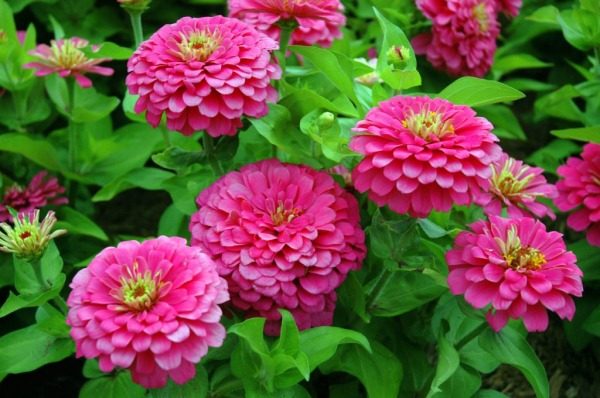
Petunia
Resistant to pests, unpretentious, having many wonderful colors, petunia has become a favorite of gardeners. It blooms luxuriantly throughout the season until frost. In the southern regions it is grown as a perennial, in the northern latitudes only one season grows.
To plant seedlings at the end of spring, in a sunny place without drafts. Also loved as a houseplant. Many summer residents plant it in the summer in the garden, and in winter they transfer it in a pot to the house, where it can begin to bloom closer to the warm spring days.

Marigold
The most popular plants for every summer resident, blooming all summer. Marigolds, densely planted, can create a dense bright carpet of orange and yellow buds on a background of green leaves. The plant is unpretentious, undemanding to watering, temperature drops, humidity.
Plant Features:
- blooms from June to the start of frost;
- loves loosening the soil and sparse watering;
- requires pruning wilted buds;
- perfectly transfers the transplant at any time (with a lump of land);
- prefers fertile loamy soil.
Salvia
Behind the exotic name lies the sage known to us. The plant has a light aroma, looks beautiful in flower beds, and is used in cooking. He loves partial shade, but feels rather well in the bright sun. Planted with seedlings at the very end of spring, blooms before frost. He loves light sandy, humus-rich soils.
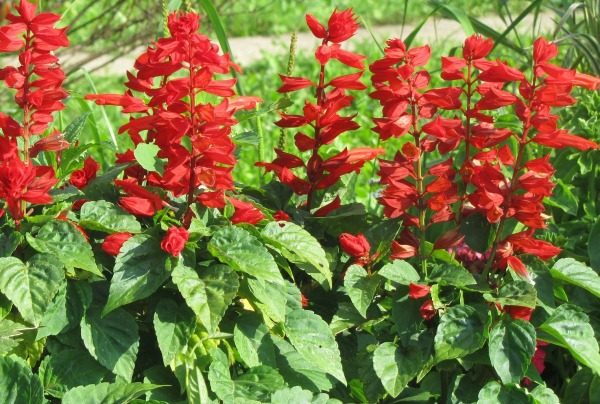
Calendula
The plant is very unpretentious, planted once on a site, propagates itself self-sowing, it is not demanding on the soil, it blooms from early summer until September-October. For the elongated form of flowers, the people nicknamed marigolds. To plant seedlings at the end of spring, seeds - in the fall, in November, or in the spring in April.
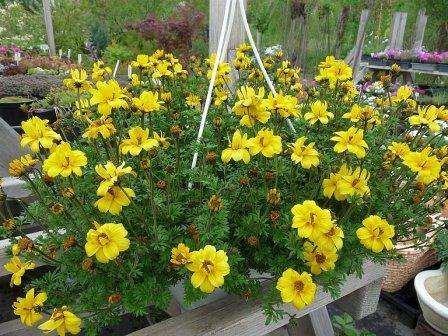 You may be interested in:
You may be interested in:Features:
- loves sunny open places;
- requires light periodic weeding and rare watering;
- frost resistant;
- has healing properties;
- on garden beds it is used as pest protection.
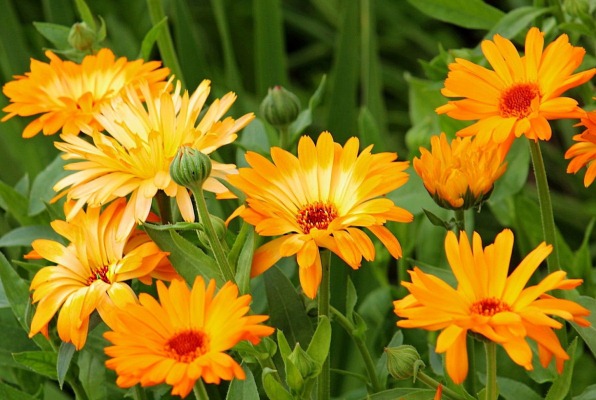
Nasturtium
A beautiful annual in the southern regions can be used as a perennial. It has many varieties, varieties and hybrids. A plant with beautiful foliage, and bright flowers in the form of a hood or helmet. The flowers are single, large, but elegant, with a delicate aroma. Planted densely, plants can create a beautiful bright carpet on a green background of foliage.
Features:
- Does not like excess moisture;
- requires periodic loosening of the soil;
- it is necessary to remove wilted peduncles;
- Soak the seeds before planting in order to get rid of the upper wrinkled peel.
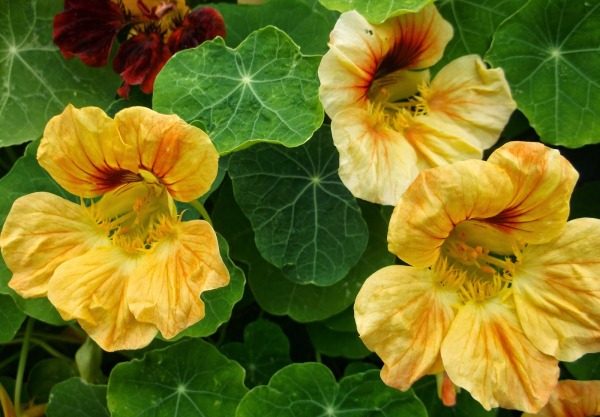
Brahikoma
It looks like an ordinary chamomile, but with colored petals. He prefers dry soil, rare watering, is unpretentious, for which he is loved by all gardeners. It is a beautiful annual of the astro family. In warm latitudes it can be grown as a perennial with a life span of about three years. In the northern regions more than one season does not live, because it does not tolerate cold weather. Blooms all summer, planted with seeds in May.
The plant can take root on any soil, blooms luxuriantly, with a large bush, with many inflorescences. Depending on the varieties, it has many colors, from purple to white, with a dark center. Shrubs are low, usually more than 30 cm do not grow, with strongly branching stems.
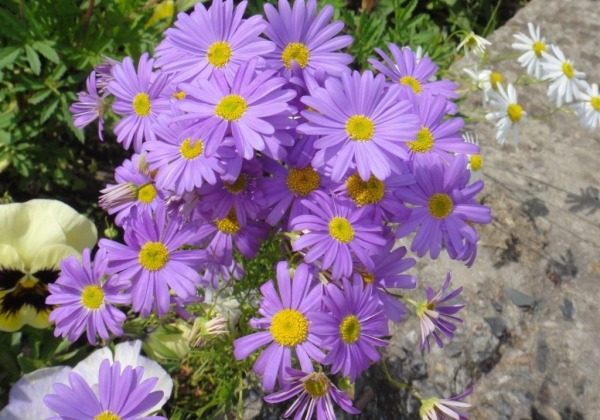
Lobelia
Beautiful delicate flower with enchanting range of shades. It takes root at any site, is used in various compositions, such as the design of garden paths, flower beds, mixborders. A universal plant that combines with all the design styles of the garden.
Planted with seedlings in late spring, preferably in sunny areas. Can tolerate partial shade. It blooms all summer through September, from the beginning of June. The flowers are small but frequent, growing with a lush low carpet. Lobelia is good as a groundcover for decorating flower beds.
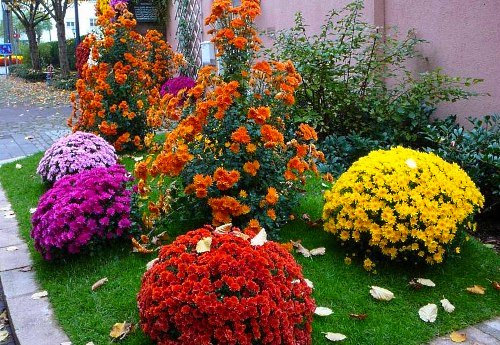 You may be interested in:
You may be interested in:Cosmea
A beautiful unpretentious annual that can decorate any garden. It easily tolerates cold, blooms before frost. Planted with seeds in April or autumn in November. Seedlings can be transferred to the garden in late May. He loves sunny places without drafts.
Features:
- requires rare watering and loosening;
- it is necessary to remove withered buds;
- does not tolerate the shadow.
When planting annual crops, you need to focus on weather conditions. With a good warming up of the land, planting earlier than the specified time, and with strong heat, seedlings will not take root. Flowering time may differ from that indicated on the package, depending on the climate of the planting region. When sowing seeds in autumn, it is necessary to wait until the soil is completely frozen to avoid the appearance of sprouts that will not tolerate frost.




 Sow in the ground, without seedlings: 10 beautiful and unpretentious flowers
Sow in the ground, without seedlings: 10 beautiful and unpretentious flowers Platicodon planting and outdoor care
Platicodon planting and outdoor care Hosta - planting and care in the open ground in the Urals
Hosta - planting and care in the open ground in the Urals Oleander - care and growing at home
Oleander - care and growing at home